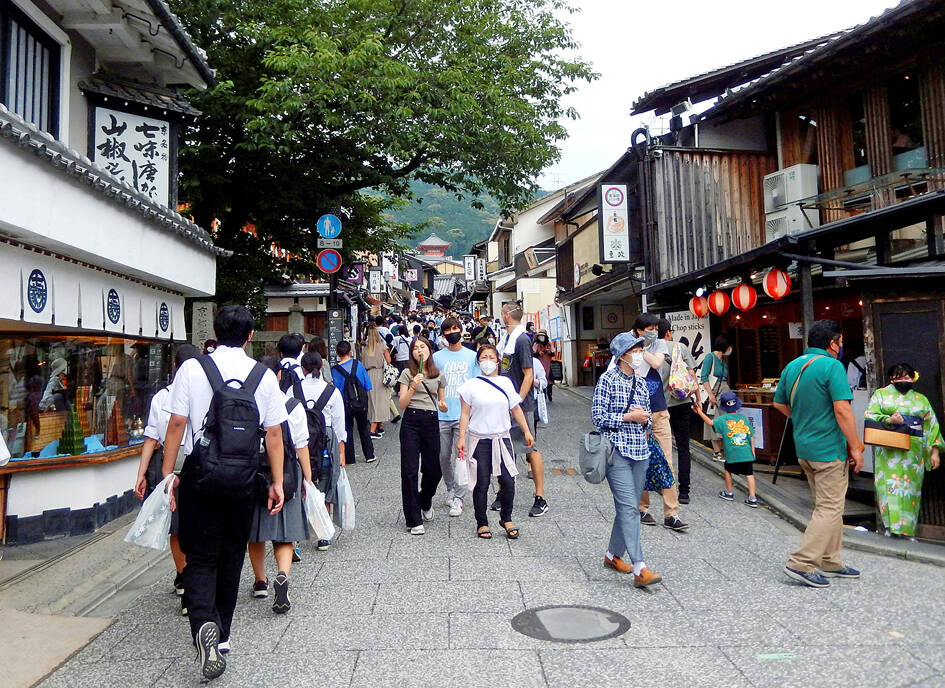Japan welcomed 25 million tourists last year, the largest number since 2019, as a weak yen helped attract post-COVID-19 pandemic visitors in a boost to the nation’s fragile economy.
The number of inbound tourists last year compared with 3.8 million in 2022, the Japanese National Tourism Organization reported yesterday.
Last month also marked the seventh consecutive month in which the number of foreign visitors exceeded 2 million, for the highest figure in that month on record.

Photo: Reuters
The return of large numbers of visitors to Japan is a positive development for an economy that shrank at the sharpest pace since the height of the pandemic in the summer. Weakness in the currency has helped boost tourists’ spending power, making Japan a much more affordable destination. The yen averaged about 140.5 against the US dollar last year.
Spending by visitors totaled a record ¥5.3 trillion (US$35.9 billion) last year, up by about 10 percent compared with the tally in 2019, before the pandemic, while spending per person increased by almost 34 percent to ¥212,000, the Japan Tourism Agency said.
Outlays by visitors came to ¥1.7 trillion in the final quarter of last year, a 21 percent increase from the third quarter, a positive result for the Japanese economy as domestic demand wilts due to high prices.
“GDP will swing back to a positive reading in the fourth quarter with help from strong inbound tourism. I don’t see any factors that could slow down the tourism recovery,” Daiwa Securities Co chief market economist Mari Iwashita said. “But I’m not sure if domestic spending will recover into positive readings because there are some lingering effects of inflation on domestic consumers.”
Still, the annual number of visitors remains below the 32 million figure recorded in 2019. Inbound tourists from China, the largest group before the pandemic and the biggest spenders, also lag behind pre-COVID-19 numbers at 2.4 million people compared with 9.6 million visitors in 2019, despite the end of Beijing’s ban on tour groups to Japan.
China has been struggling with its own gloomy economic data, while tensions also remain over Japan’s release of wastewater from its Fukushima Dai-ichi nuclear power plant reactor.
The largest number of visitors came from South Korea and Taiwan last year, with 7 million and 4 million respectively. Singapore and the US were also among the nations with more tourists visiting Japan than before the pandemic.
The Japanese government has set an ambitious goal for 2030 of 60 million visitors, and a target of ¥15 trillion for their spending, according to the Japanese Ministry of Economy, Trade and Industry.
It remains to be seen how the Noto earthquake would affect tourism.

Taiwan Semiconductor Manufacturing Co (TSMC, 台積電) would not produce its most advanced technologies in the US next year, Minister of Economic Affairs J.W. Kuo (郭智輝) said yesterday. Kuo made the comment during an appearance at the legislature, hours after the chipmaker announced that it would invest an additional US$100 billion to expand its manufacturing operations in the US. Asked by Taiwan People’s Party Legislator-at-large Chang Chi-kai (張啟楷) if TSMC would allow its most advanced technologies, the yet-to-be-released 2-nanometer and 1.6-nanometer processes, to go to the US in the near term, Kuo denied it. TSMC recently opened its first US factory, which produces 4-nanometer

GREAT SUCCESS: Republican Senator Todd Young expressed surprise at Trump’s comments and said he expects the administration to keep the program running US lawmakers who helped secure billions of dollars in subsidies for domestic semiconductor manufacturing rejected US President Donald Trump’s call to revoke the 2022 CHIPS and Science Act, signaling that any repeal effort in the US Congress would fall short. US Senate Minority Leader Chuck Schumer, who negotiated the law, on Wednesday said that Trump’s demand would fail, while a top Republican proponent, US Senator Todd Young, expressed surprise at the president’s comments and said he expects the administration to keep the program running. The CHIPS Act is “essential for America leading the world in tech, leading the world in AI [artificial

REACTIONS: While most analysts were positive about TSMC’s investment, one said the US expansion could disrupt the company’s supply-demand balance Taiwan Semiconductor Manufacturing Co’s (TSMC, 台積電) new US$100 billion investment in the US would exert a positive effect on the chipmaker’s revenue in the medium term on the back of booming artificial intelligence (AI) chip demand from US chip designers, an International Data Corp (IDC) analyst said yesterday. “This is good for TSMC in terms of business expansion, as its major clients for advanced chips are US chip designers,” IDC senior semiconductor research manager Galen Zeng (曾冠瑋) said by telephone yesterday. “Besides, those US companies all consider supply chain resilience a business imperative,” Zeng said. That meant local supply would

Servers that might contain artificial intelligence (AI)-powering Nvidia Corp chips shipped from the US to Singapore ended up in Malaysia, but their actual final destination remains a mystery, Singaporean Minister for Home Affairs and Law K Shanmugam said yesterday. The US is cracking down on exports of advanced semiconductors to China, seeking to retain a competitive edge over the technology. However, Bloomberg News reported in late January that US officials were probing whether Chinese AI firm DeepSeek (深度求索) bought advanced Nvidia semiconductors through third parties in Singapore, skirting Washington’s restrictions. Shanmugam said the route of the chips emerged in the course of an